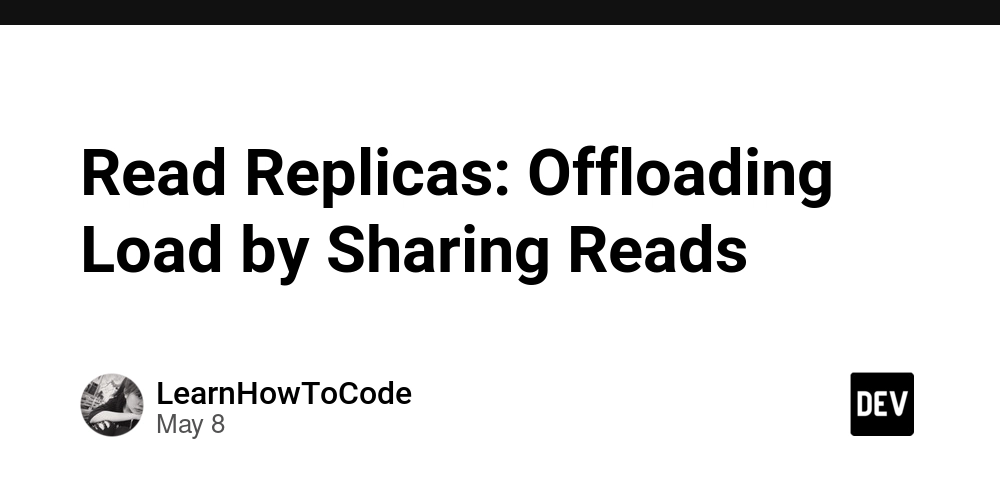Read Replicas: Offloading Load by Sharing Reads
When your system is still small, you have only one database. All operations — both reads and writes — go through the same path, and everything seems to flow naturally. But then the system starts to grow. Users multiply. The number of queries increases exponentially. And you will realize a simple truth: most of the requests are merely read operations. Browsing products. Scrolling through a timeline. Searching for posts. Each of these actions consumes I/O, CPU, and memory resources on the database. At first, you may think, "It’s just reading — how heavy can it be?" But reads, when there are enough of them, can gradually and surely choke the system. That’s when read replicas become a weapon you must consider. The solution is conceptually simple: you replicate your primary database into multiple copies — replicas that serve read traffic only. The master database focuses on writing new data, while the replicas distribute the read load across multiple nodes, creating more open lanes for traffic to flow smoothly. If you implement this correctly, the system will dramatically reduce the pressure on the master and greatly increase its read capacity. But there’s no such thing as a free lunch. Replication always introduces a delay — the so-called replication lag. When you write new data to the master, it takes a short amount of time for that update to synchronize to the replicas. And during that brief lag, users may see an outdated version of the data. They might update their profile but still see the old information when they reload. They might purchase a product but still see the item listed as "in stock" in their cart. If you don’t understand replication lag, you might think your system is broken. If you do understand it, you’ll know: this is an acceptable trade-off for achieving higher scalability. A high-load system doesn’t try to eliminate replication lag. It learns to live with it and manage it properly. For example, for critical actions that require real-time data accuracy, such as confirming an order, you can design the system to read directly from the master. For less time-sensitive actions, like browsing public product catalogs, you can route reads to replicas. This is an art of balance, not a rigid formula. But lag is only part of the story. You must also prepare for failover — the situation when the master database suddenly fails. When that happens, you need to act quickly: promote a replica to become the new master and update the system's routing accordingly. Without a prepared failover strategy, a database failure can quickly spiral into system-wide chaos. Proper failover requires strict management of the replication topology, continuous health monitoring of nodes, and either automated or at least semi-automated failover processes. And in reality, executing a clean, consistent failover is no easy feat. Many systems have suffered prolonged downtimes simply because they underestimated this problem. I want you to remember one thing: Read replicas are not a magic wand. They are only powerful if you truly understand their nature, prepare the right way, and consciously accept their natural limitations. You don’t scale reads infinitely just by adding more replicas. You scale reads properly when your system knows how to manage replication lag, route requests intelligently, and automate failover to keep the heart of your data beating steadily even when disruptions occur. Further Reading If you found this article helpful and you’re keen on optimizing algorithms and honing your algorithmic thinking, I highly recommend the book Algorithm Mindset. It doesn’t just walk you through real-world problem-solving, it also helps you cultivate an algorithmic mindset in the most intuitive way.

When your system is still small, you have only one database. All operations — both reads and writes — go through the same path, and everything seems to flow naturally. But then the system starts to grow. Users multiply. The number of queries increases exponentially. And you will realize a simple truth: most of the requests are merely read operations.
Browsing products. Scrolling through a timeline. Searching for posts. Each of these actions consumes I/O, CPU, and memory resources on the database. At first, you may think, "It’s just reading — how heavy can it be?" But reads, when there are enough of them, can gradually and surely choke the system.
That’s when read replicas become a weapon you must consider.
The solution is conceptually simple: you replicate your primary database into multiple copies — replicas that serve read traffic only. The master database focuses on writing new data, while the replicas distribute the read load across multiple nodes, creating more open lanes for traffic to flow smoothly.
If you implement this correctly, the system will dramatically reduce the pressure on the master and greatly increase its read capacity.
But there’s no such thing as a free lunch.
Replication always introduces a delay — the so-called replication lag. When you write new data to the master, it takes a short amount of time for that update to synchronize to the replicas. And during that brief lag, users may see an outdated version of the data. They might update their profile but still see the old information when they reload. They might purchase a product but still see the item listed as "in stock" in their cart.
If you don’t understand replication lag, you might think your system is broken. If you do understand it, you’ll know: this is an acceptable trade-off for achieving higher scalability.
A high-load system doesn’t try to eliminate replication lag. It learns to live with it and manage it properly.
For example, for critical actions that require real-time data accuracy, such as confirming an order, you can design the system to read directly from the master. For less time-sensitive actions, like browsing public product catalogs, you can route reads to replicas.
This is an art of balance, not a rigid formula.
But lag is only part of the story.
You must also prepare for failover — the situation when the master database suddenly fails. When that happens, you need to act quickly: promote a replica to become the new master and update the system's routing accordingly.
Without a prepared failover strategy, a database failure can quickly spiral into system-wide chaos.
Proper failover requires strict management of the replication topology, continuous health monitoring of nodes, and either automated or at least semi-automated failover processes.
And in reality, executing a clean, consistent failover is no easy feat. Many systems have suffered prolonged downtimes simply because they underestimated this problem.
I want you to remember one thing:
Read replicas are not a magic wand. They are only powerful if you truly understand their nature, prepare the right way, and consciously accept their natural limitations.
You don’t scale reads infinitely just by adding more replicas. You scale reads properly when your system knows how to manage replication lag, route requests intelligently, and automate failover to keep the heart of your data beating steadily even when disruptions occur.
Further Reading
If you found this article helpful and you’re keen on optimizing algorithms and honing your algorithmic thinking, I highly recommend the book Algorithm Mindset. It doesn’t just walk you through real-world problem-solving, it also helps you cultivate an algorithmic mindset in the most intuitive way.









































































































































































![[The AI Show Episode 146]: Rise of “AI-First” Companies, AI Job Disruption, GPT-4o Update Gets Rolled Back, How Big Consulting Firms Use AI, and Meta AI App](https://www.marketingaiinstitute.com/hubfs/ep%20146%20cover.png)

























































































































![[DEALS] The Premium Python Programming PCEP Certification Prep Bundle (67% off) & Other Deals Up To 98% Off – Offers End Soon!](https://www.javacodegeeks.com/wp-content/uploads/2012/12/jcg-logo.jpg)















































































































































_Aleksey_Funtap_Alamy.jpg?width=1280&auto=webp&quality=80&disable=upscale#)
_Sergey_Tarasov_Alamy.jpg?width=1280&auto=webp&quality=80&disable=upscale#)













































































































![Apple Foldable iPhone to Feature New Display Tech, 19% Thinner Panel [Rumor]](https://www.iclarified.com/images/news/97271/97271/97271-640.jpg)
![Apple Developing New Chips for Smart Glasses, Macs, AI Servers [Report]](https://www.iclarified.com/images/news/97269/97269/97269-640.jpg)
![Apple Shares New Mother's Day Ad: 'A Gift for Mom' [Video]](https://www.iclarified.com/images/news/97267/97267/97267-640.jpg)
![Apple Shares Official Trailer for 'Stick' Starring Owen Wilson [Video]](https://www.iclarified.com/images/news/97264/97264/97264-640.jpg)







































































































